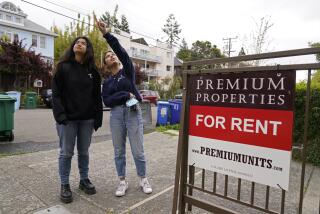April Housing Starts Drop 17%, the Steepest in 8 Years : Construction: The decline, which was larger than expected, calls into question the strength of the recovery.
WASHINGTON — Construction of new homes and apartments plunged 17% in April, the sharpest drop in eight years, the government said Tuesday in a report that raised questions about the strength of the recovery.
The decline in housing construction was evident in every region of the country, the Commerce Department reported. Permits issued for future building also fell, suggesting that the housing sector may remain less than robust in coming months.
The rate of decline in construction was much steeper than expected, and could put more pressure on the Federal Reserve Board to reduce interest rates further to keep the recovery on track. Private economists had expected housing starts to fall only 5% to 8.5% in April.
The Fed’s rate-setting Open Market Committee met privately Tuesday to discuss current conditions, but there was no immediate indication of its plans. Even so, stock and bond markets surged on speculation that another rate cut is imminent.
The disappointing housing figures were released only a day after President Bush, speaking to the National Assn. of Home Builders, touted the role of construction in spurring recovery, citing a 15.8% gain in housing starts during the first quarter.
“The old adage is coming true: As housing goes, so goes the economy,” Bush told the association.
“Everything the President said was just fine,” White House spokesman Marlin Fitzwater said after the April numbers were released. “We think we are in a recovery, and all the statistics show that. This is a one-month housing drop, but it doesn’t change the basic conclusion that the economy is recovering, and we’re very encouraged by it.”
Fitzwater noted that the March-to-April decline followed “four strong monthly increases” and said the Administration believes that housing starts “will continue their long trend upward, long term.”
Although the severity of the April decline caught economists by surprise, several analysts said they remained confident that the recovery will continue. Even with the one-month plunge, the level of housing construction was higher last month than in April, 1991.
Some analysts attributed last month’s slowdown to the impact of mortgage rates, which have been creeping upward several months, as well as abnormally warm weather earlier in the year, which prompted contractors to start building sooner than usual.
Kent Colton, executive vice president of the home builders association, noted that 24% of economic growth during the January-March quarter was attributable to home construction.
That growth “is now in jeopardy if housing keeps slowing down for the rest of the second quarter the way it did in April,” Colton said. “Hopefully, these April numbers will be a signal to the Fed that the economy is not overheating and that it can safely lower rates.”
Mark Obrinsky, an economist with the Federal National Mortgage Assn., noted that mortgage rates have started to decline again in recent days, a factor that “will be a plus” for housing construction.
Lawrence A. Hunter, chief economist for the U.S. Chamber of Commerce, was also optimistic about the future. Hunter said the March increase of 6.9% “was not sustainable, and housing is still in much better shape than last year.”
Hunter said he believes that April’s housing starts will establish a “floor” for the year. “The important thing to understand is that housing starts are above last year’s very depressed levels, and as 1992 proceeds, starts should improve gradually as longer-term interest rates fall and as the economy ekes out a sluggish recovery,” he said.
Housing starts fell in April to a seasonally adjusted annual rate of 1.115 million units, the Commerce Department reported. It was the biggest fall-off in a single month since a 26% decline in March, 1984.
Construction of single-family houses fell 10.6% to an adjusted annual rate of 963,000 after slipping 2.9% a month earlier. Apartment construction plummeted 43.1% in April after soaring 80.4% the previous month.
The slowdown in April construction was nationwide, affecting every region from the Northeast to the West. The largest drop was registered in the Midwest, where housing starts fell by 30.5% to an adjusted annual rate of 242,000 units. In the West, starts were down 16.7%, to a rate of 265,000 units. In the South, new construction declined by 10.7%, and in the Northeast the drop was 8.7%.
Applications for new construction permits dropped 3.3% in April after a 4.5% decline in March, indicating that the rate of new construction may continue to weaken.
Bush, addressing members of the National Retail Federation at the White House on Tuesday, said he was “encouraged” overall by the economy’s performance but acknowledged that the public seems more pessimistic.
“It’s odd,” he said of surveys suggesting that Americans believe that the economy is getting worse. “This is true even though most economists now and most business people are saying, ‘Hey, it’s beginning to move.’ And I think you’ll see some growth figures that confirm that.”
The President told the retailers that “there’s a psychological, a confidence problem out there that I’m sure adversely affects some of your interests, some of your business.” He added that “we are going to try to gun down some of this pessimism you get on the top of every news broadcast.”
Times staff writer James Gerstenzang contributed to this report.
Housing Starts Drop Seasonally adjusted annual rate, millions of units Apr. ‘91: 0.98 Mar. ‘92: 1.34 Apr.: ‘92: 1.12 Source: U.S. Dept. of Commerce * MARKET BEAT: Home builders’ stocks hit hard. D3.
More to Read
Inside the business of entertainment
The Wide Shot brings you news, analysis and insights on everything from streaming wars to production — and what it all means for the future.
You may occasionally receive promotional content from the Los Angeles Times.










